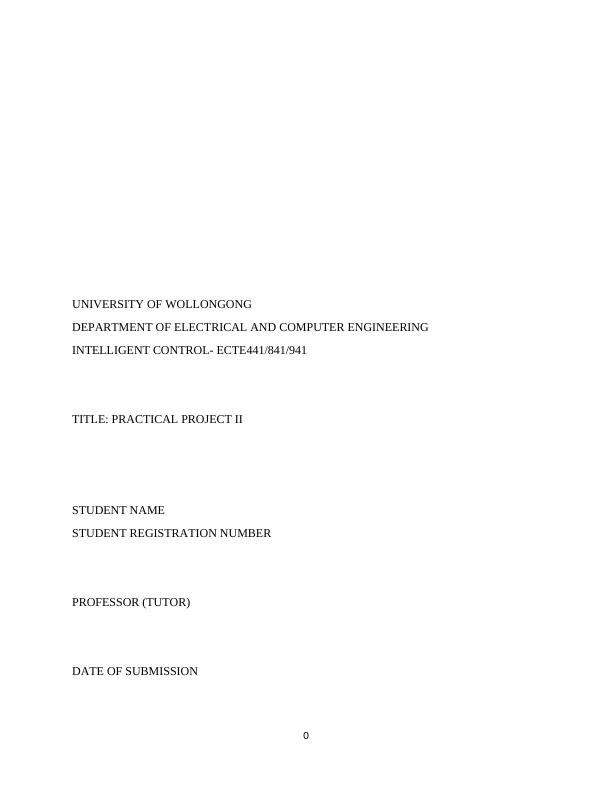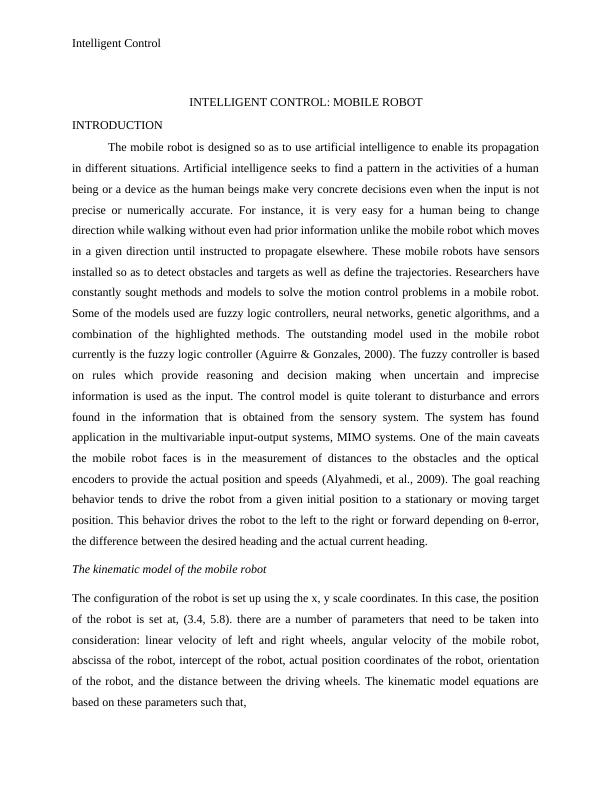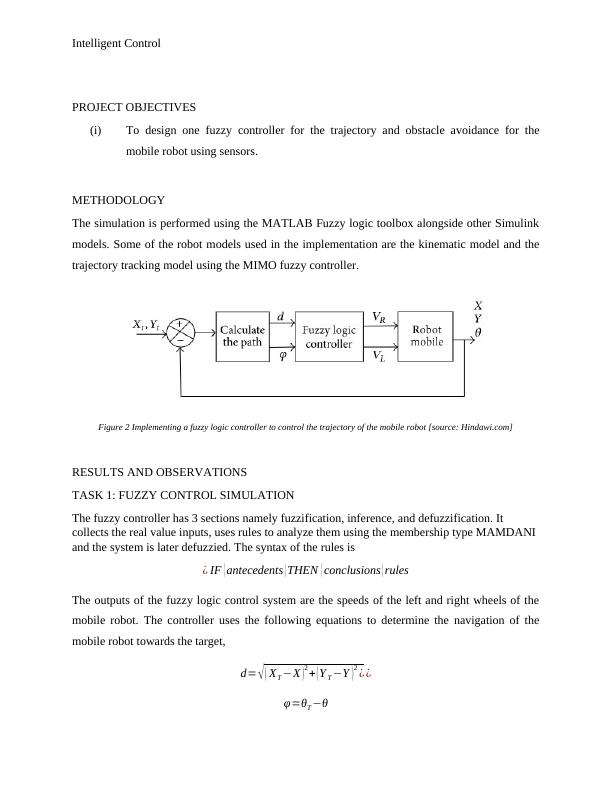Intelligent Control: Mobile Robot
15 Pages1928 Words398 Views
Added on 2023-06-13
About This Document
This practical project explores the design and implementation of fuzzy logic controllers for mobile robots. It covers the kinematic model of the robot, fuzzy control simulation, and fuzzy ANFIS control. The project also discusses the use of hybrid systems and odometry for robot navigation. The simulation is performed using MATLAB Fuzzy logic toolbox and other Simulink models.
Intelligent Control: Mobile Robot
Added on 2023-06-13
ShareRelated Documents
UNIVERSITY OF WOLLONGONG
DEPARTMENT OF ELECTRICAL AND COMPUTER ENGINEERING
INTELLIGENT CONTROL- ECTE441/841/941
TITLE: PRACTICAL PROJECT II
STUDENT NAME
STUDENT REGISTRATION NUMBER
PROFESSOR (TUTOR)
DATE OF SUBMISSION
0
DEPARTMENT OF ELECTRICAL AND COMPUTER ENGINEERING
INTELLIGENT CONTROL- ECTE441/841/941
TITLE: PRACTICAL PROJECT II
STUDENT NAME
STUDENT REGISTRATION NUMBER
PROFESSOR (TUTOR)
DATE OF SUBMISSION
0

Intelligent Control
INTELLIGENT CONTROL: MOBILE ROBOT
INTRODUCTION
The mobile robot is designed so as to use artificial intelligence to enable its propagation
in different situations. Artificial intelligence seeks to find a pattern in the activities of a human
being or a device as the human beings make very concrete decisions even when the input is not
precise or numerically accurate. For instance, it is very easy for a human being to change
direction while walking without even had prior information unlike the mobile robot which moves
in a given direction until instructed to propagate elsewhere. These mobile robots have sensors
installed so as to detect obstacles and targets as well as define the trajectories. Researchers have
constantly sought methods and models to solve the motion control problems in a mobile robot.
Some of the models used are fuzzy logic controllers, neural networks, genetic algorithms, and a
combination of the highlighted methods. The outstanding model used in the mobile robot
currently is the fuzzy logic controller (Aguirre & Gonzales, 2000). The fuzzy controller is based
on rules which provide reasoning and decision making when uncertain and imprecise
information is used as the input. The control model is quite tolerant to disturbance and errors
found in the information that is obtained from the sensory system. The system has found
application in the multivariable input-output systems, MIMO systems. One of the main caveats
the mobile robot faces is in the measurement of distances to the obstacles and the optical
encoders to provide the actual position and speeds (Alyahmedi, et al., 2009). The goal reaching
behavior tends to drive the robot from a given initial position to a stationary or moving target
position. This behavior drives the robot to the left to the right or forward depending on θ-error,
the difference between the desired heading and the actual current heading.
The kinematic model of the mobile robot
The configuration of the robot is set up using the x, y scale coordinates. In this case, the position
of the robot is set at, (3.4, 5.8). there are a number of parameters that need to be taken into
consideration: linear velocity of left and right wheels, angular velocity of the mobile robot,
abscissa of the robot, intercept of the robot, actual position coordinates of the robot, orientation
of the robot, and the distance between the driving wheels. The kinematic model equations are
based on these parameters such that,
INTELLIGENT CONTROL: MOBILE ROBOT
INTRODUCTION
The mobile robot is designed so as to use artificial intelligence to enable its propagation
in different situations. Artificial intelligence seeks to find a pattern in the activities of a human
being or a device as the human beings make very concrete decisions even when the input is not
precise or numerically accurate. For instance, it is very easy for a human being to change
direction while walking without even had prior information unlike the mobile robot which moves
in a given direction until instructed to propagate elsewhere. These mobile robots have sensors
installed so as to detect obstacles and targets as well as define the trajectories. Researchers have
constantly sought methods and models to solve the motion control problems in a mobile robot.
Some of the models used are fuzzy logic controllers, neural networks, genetic algorithms, and a
combination of the highlighted methods. The outstanding model used in the mobile robot
currently is the fuzzy logic controller (Aguirre & Gonzales, 2000). The fuzzy controller is based
on rules which provide reasoning and decision making when uncertain and imprecise
information is used as the input. The control model is quite tolerant to disturbance and errors
found in the information that is obtained from the sensory system. The system has found
application in the multivariable input-output systems, MIMO systems. One of the main caveats
the mobile robot faces is in the measurement of distances to the obstacles and the optical
encoders to provide the actual position and speeds (Alyahmedi, et al., 2009). The goal reaching
behavior tends to drive the robot from a given initial position to a stationary or moving target
position. This behavior drives the robot to the left to the right or forward depending on θ-error,
the difference between the desired heading and the actual current heading.
The kinematic model of the mobile robot
The configuration of the robot is set up using the x, y scale coordinates. In this case, the position
of the robot is set at, (3.4, 5.8). there are a number of parameters that need to be taken into
consideration: linear velocity of left and right wheels, angular velocity of the mobile robot,
abscissa of the robot, intercept of the robot, actual position coordinates of the robot, orientation
of the robot, and the distance between the driving wheels. The kinematic model equations are
based on these parameters such that,

Intelligent Control
dx
dt =V L+V R
2 cos θ
dy
dt =V L+V R
2 sinθ
dθ
dt = V L−V R
2
Figure 1 Kinematic model of the mobile robot [source: Hindawi.com]
These equations are used in the MATLAB simulation of the mobile robot. The kinematic
equation can also be expressed in discrete form,
X k+1= Xk+ T ( V rk +V lk )
2 cos θk
Y k +1=Y k +T ( V rk +V lk )
2 sin θk
θk+1=θk+T ( V rk +V lk )
2
dx
dt =V L+V R
2 cos θ
dy
dt =V L+V R
2 sinθ
dθ
dt = V L−V R
2
Figure 1 Kinematic model of the mobile robot [source: Hindawi.com]
These equations are used in the MATLAB simulation of the mobile robot. The kinematic
equation can also be expressed in discrete form,
X k+1= Xk+ T ( V rk +V lk )
2 cos θk
Y k +1=Y k +T ( V rk +V lk )
2 sin θk
θk+1=θk+T ( V rk +V lk )
2

Intelligent Control
PROJECT OBJECTIVES
(i) To design one fuzzy controller for the trajectory and obstacle avoidance for the
mobile robot using sensors.
METHODOLOGY
The simulation is performed using the MATLAB Fuzzy logic toolbox alongside other Simulink
models. Some of the robot models used in the implementation are the kinematic model and the
trajectory tracking model using the MIMO fuzzy controller.
Figure 2 Implementing a fuzzy logic controller to control the trajectory of the mobile robot [source: Hindawi.com]
RESULTS AND OBSERVATIONS
TASK 1: FUZZY CONTROL SIMULATION
The fuzzy controller has 3 sections namely fuzzification, inference, and defuzzification. It
collects the real value inputs, uses rules to analyze them using the membership type MAMDANI
and the system is later defuzzied. The syntax of the rules is
¿ IF { antecedents } THEN { conclusions } rules
The outputs of the fuzzy logic control system are the speeds of the left and right wheels of the
mobile robot. The controller uses the following equations to determine the navigation of the
mobile robot towards the target,
d= √ ( XT −X )2 + ( Y T −Y )2 ¿ ¿
φ=θT −θ
PROJECT OBJECTIVES
(i) To design one fuzzy controller for the trajectory and obstacle avoidance for the
mobile robot using sensors.
METHODOLOGY
The simulation is performed using the MATLAB Fuzzy logic toolbox alongside other Simulink
models. Some of the robot models used in the implementation are the kinematic model and the
trajectory tracking model using the MIMO fuzzy controller.
Figure 2 Implementing a fuzzy logic controller to control the trajectory of the mobile robot [source: Hindawi.com]
RESULTS AND OBSERVATIONS
TASK 1: FUZZY CONTROL SIMULATION
The fuzzy controller has 3 sections namely fuzzification, inference, and defuzzification. It
collects the real value inputs, uses rules to analyze them using the membership type MAMDANI
and the system is later defuzzied. The syntax of the rules is
¿ IF { antecedents } THEN { conclusions } rules
The outputs of the fuzzy logic control system are the speeds of the left and right wheels of the
mobile robot. The controller uses the following equations to determine the navigation of the
mobile robot towards the target,
d= √ ( XT −X )2 + ( Y T −Y )2 ¿ ¿
φ=θT −θ

End of preview
Want to access all the pages? Upload your documents or become a member.
Related Documents
Mobile Robotics : Assignmentlg...
|16
|2041
|182
